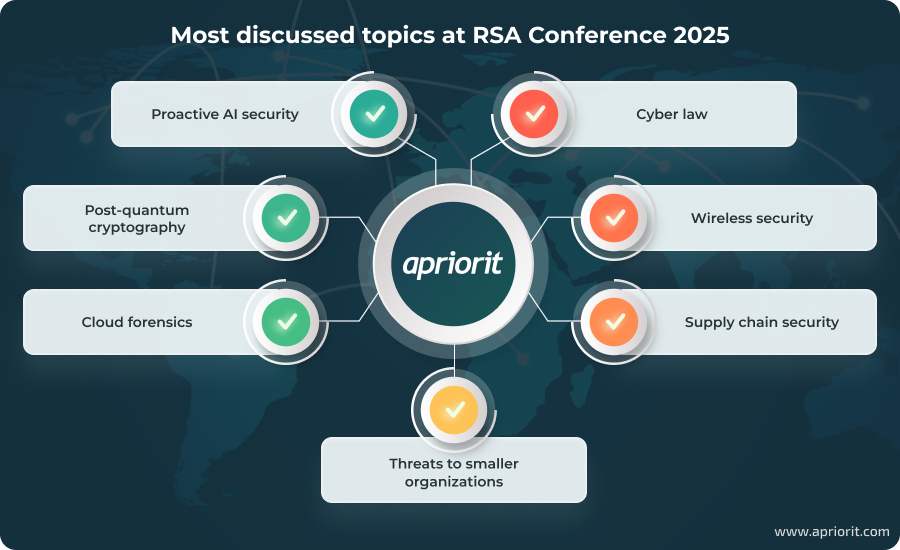This year’s RSA Conference has just wrapped up in San Francisco, and once again, it brought us the latest news in cybersecurity innovation, strategy, and resilience. Every year, RSA gathers the cybersecurity industry’s top minds to prepare for emerging threats and shape the future of digital defences.
As a trusted partner in secure software development, Apriorit makes it a priority to follow cybersecurity trends. We help our clients stay on top of the latest security-related developments by connecting with technology leaders, accumulating internal expertise, and analyzing emergent risks and threats.
In this article, we will discuss the main cybersecurity trends covered at RSA Conference 2025, from the rise of AI in cybersecurity to evolving cloud forensics. This short RSA Conference 2025 summary will give you a glimpse at the future of cybersecurity and help you prepare your software for it (with Apriorit’s help).
Contents:
- Key cybersecurity trends from RSA Conference 2025
- AI-powered cybersecurity goes proactive
- The quantum era demands crypto-agility
- Cloud security forensics becomes a must
- Advanced threats expand to smaller targets
- Supply chain security is more important than ever
- Next-gen wireless networks need to be secured
- Cyber law becomes a core security discussion
- Turn trends into action with Apriorit
Key cybersecurity trends from RSA Conference 2025
Every year, RSA Conference sets the tone for what’s ahead in cybersecurity, and 2025 was no exception. This year’s agenda was packed with pressing topics that reflect quickly changing security challenges and priorities. Here are the most talked-about RSA Conference 2025 cybersecurity trends.

AI-powered cybersecurity goes proactive
Artificial intelligence is no longer just an emerging technology; it is a critical tool for staying ahead of advanced threats. One of the RSA sessions — Catch Attackers Before They Strike with AI-powered Threat Intelligence, led by Nadir Izrael — explored how AI is enabling a shift from reactive defense to proactive operations. As critical infrastructure becomes a primary target for AI-driven cyberattacks and nation-state actors, organizations must adapt by using AI not only for detection but for preventive threat modeling and intervention.
The quantum era demands crypto-agility
The rise of quantum computing presents a fundamental challenge to current cryptographic standards. Several sessions focused on quantum algorithms and quantum-resistant defences. In Quantum Computing and Digital Signatures, Hoyt L. Kesterson II stressed that when quantum computing reaches practical maturity, malicious actors will use it to break today’s asymmetric encryption and weaken symmetric encryption. This could potentially endanger both future and already signed documents.
During other sessions, experts presented strategies for migrating to quantum-resistant algorithms, outlining a complex but essential path toward crypto-agility. As the cryptographic paradigm shifts, organizations must start preparing for the post-quantum future now. Our experts have already begun doing so by integrating post-quantum algorithms.
Cloud security forensics becomes a must
As cloud adoption becomes even more widespread, the ability to investigate incidents in SaaS and multi-cloud environments is no longer optional. Traditional forensic tools, which are typically designed for on-premises systems, don’t apply to these dynamic infrastructures. These tools often miss critical risks like lateral movement across cloud services or identity-based attacks. In a session titled Building a Resilient Cloud Security Foundation, Rich Mogull outlined how to adapt security operations to collect evidence, identify threats, and respond effectively in cloud-native environments.
Advanced threats expand to smaller targets
Nation-state actors are shifting their focus from major enterprises to smaller organizations, supply chains, and vendors. These “soft targets” provide indirect access to high-value systems. For example, during the session Under Siege: How APTs and Nation-States Are Coming for Everyone, speakers Eric Chien and Jason Rolleston stressed the need for widespread threat awareness, as no entity, large or small, is immune to becoming a gateway for more significant attacks. Proactive measures like AI-driven and Zero Trust architectures can help organizations identify and stop attacks before they spread.
Read also
6 Emerging Cybersecurity Trends for 2025 to Futureproof Your Product
Gain practical insights into cybersecurity trends that matter in 2025. Learn how development teams can mitigate growing risks from the start of the SDLC.

Supply chain security is more important than ever
Modern organizations should treat supply chain security as a frontline defense, not as an afterthought. In light of high-impact incidents like the 2024 Lebanon pager attacks, protecting the technology supply chain has become a global priority. Such incidents have highlighted how digital attacks intersect with geopolitical tensions and are redefining modern warfare.
The session A Stuxnet Moment for Supply Chain Security? focused on how to future-proof supply chains by improving transparency, visibility, and real-time risk assessment at every link. Speaker Andrea Little Limbago explained that this can be achieved through tools like Software Bills of Materials, continuous monitoring platforms, and AI-powered threat detection integrated across the development and deployment pipeline.
Next-gen wireless networks need to be secured
With the rollout of 5G and the adoption of Wi-Fi 6E, 7, and 8, wireless communication is developing quickly, and so are its vulnerabilities. New communication technologies have changed how attackers operate, since IoT and unmanaged devices expand the attack surface and can easily be compromised.
Speakers at several sessions, such as Enhancing Wireless Security in the Era of IoT and The Inevitable Collision Between 5G and Zero Trust: Real Life Solutions, explored the growing complexity of securing unmanaged IoT devices and new wireless protocols. They discussed the Zero Trust approach as a promising strategy for dealing with the fragmented, always-connected nature of modern networks. Security professionals also discussed real-world incidents and the tools needed to protect devices in increasingly dense wireless environments.
Cyber law becomes a core security discussion
As the legal cases surrounding cybersecurity grow more complex, companies should include non-compliance and litigation risks in their strategic considerations. During the session Navigating the Legal Landscape: Cyber Law 2025, the speakers unpacked recent cyber legal cases and trends affecting both the public and private sectors. They also showed the critical role legal awareness plays in addressing cybersecurity risks.
Turn trends into action with Apriorit
Keeping up with RSA trends and staying ahead of the curve is important, but it is equally necessary to understand how to apply them in software development to make a product truly future-proof. That’s where our expertise comes in, as we turn trends into practical, secure solutions tailored to our clients’ needs.
At Apriorit, we believe that cybersecurity should be a top priority during and after software development. This is why we make sure to attend events like RSA Conference, where we participate in discussions of the technologies and strategies shaping the industry’s future.
Our services cover a wide range of areas, including:
- Secure development of custom software
- Software code audits
- IoT and wireless security
- Artificial intelligence and machine learning development
- And more
Whether you are exploring new Zero Trust architectures or preparing for the future of encryption, Apriorit will augment your project with rare technical expertise and strategic insight.
Turn today’s cybersecurity trends into tomorrow’s solutions.
Secure your next project with a partner who understands the growing threats.


